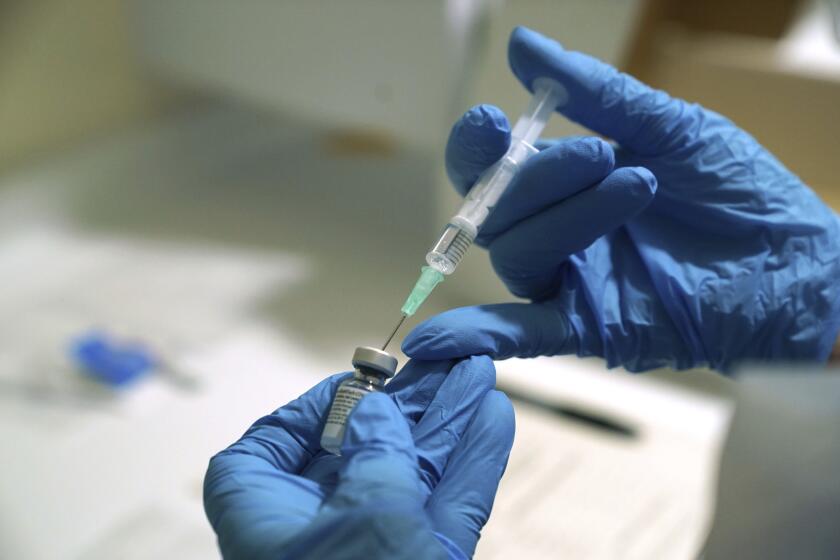Homeless people exposed to coronavirus were put in hotels. For hospitals, the move paid off

- Share via
San Francisco researchers have found an effective way to help homeless residents suffering from mild to moderate cases of COVID-19: housing them in hotel rooms, thus lowering the burden on hospitals deluged with more seriously ill patients.
The findings, published Tuesday in JAMA Network Open, underscore the public health benefits of providing stable housing and services to those who need them most.
“What they did makes absolute sense to me,” said Dr. Miriam Komaromy, an internist who specializes in addiction medicine at Boston Medical Center. “I think it’s what needs to happen in communities around the country.”
One of the first things anyone exposed to or infected with the coronavirus needs to do is quarantine or isolate — that is, hole up at home and avoid other people for several days to prevent further spread of the virus.
That’s not an option for the more than half a million homeless people in the U.S., who don’t have independent and reliable shelter. Nor is it feasible for those living in “marginal” housing, where people may live in crowded quarters or with shared facilities, often due to high housing prices.
Both groups run a higher risk of being infected and of transmitting the virus to others. And spending time in a homeless shelter comes with its own perils, since many have become COVID-19 hot spots.
This was a major concern for public health officials in San Francisco, where 8,000 people experience homelessness on a nightly basis, and 18,000 low-income people live in single-room-occupancy hotels with shared kitchens and bathrooms.
Even in the pandemic’s early days, there was clearly a need to set up alternative housing to stop the spread of SARS-CoV-2, said the study’s lead author, Dr. Jonathan Fuchs, a physician-epidemiologist with the San Francisco Department of Public Health and UC San Francisco.
The researchers acted fast. On March 19, three days after San Francisco declared one of the country’s first shelter-in-place health orders, the team began welcoming patients as guests into the first of five isolation and quarantine hotels.
For their report, the researchers evaluated the program from March 19 to May 31. Of the 1,009 guests checked into hotel rooms for isolation and quarantine, 501 were either sheltered or unsheltered homeless people; the rest were marginally housed people living in overcrowded or otherwise risky conditions.
Overall, 463 were diagnosed with COVID-19, 379 were under investigation and awaiting test results, and 146 needed to quarantine because they were close contacts of a person who had COVID-19.
At the hotels, a team of nurses, health workers and security staff supervised by a physician provided free, around-the-clock support to guests, who were monitored for COVID-19 symptoms and were called twice a day for wellness checks. Those with alcohol or other substance abuse problems were offered consultations with addiction medicine specialists via telemedicine.
Guests received hygiene kits and meals that accommodated their dietary restrictions. Those with young children were offered diapers and formula, and pets were allowed to stay on-site. The researchers also stored guests’ belongings, provided laundry services and offered $20 gift cards at the end of the stay. The median hotel stay was 10 days.
The incentives seemed to work: About 81% of guests completed the program. Those who made it through stayed an average of 13.1 days, compared with 5.5 days among those who left prematurely.
“The hotel-based strategy was likely successful for these populations because it met their needs beyond isolation and quarantine,” Dr. Joshua A. Barocas of Boston Medical Center and Dr. Esther K. Choo of Oregon Health and Science University wrote in a commentary that accompanies the paper.
Mixing and matching doses of different COVID-19 vaccines was an idea that scientists dismissed out of hand. Now they’re taking it seriously.
In sticking to the program, the hotel guests probably helped reduce the virus’ spread while also freeing up limited hospital resources — including the personnel needed to attend to more seriously ill patients.
“That really helped to decompress the hospital, particularly during the early days of the pandemic, when that was really important,” Fuchs said.
Also, out of the 346 patients who had been transferred to the hotel program from a large county public hospital, just 4% needed to return to the hospital due to worsening COVID-19 symptoms.
“That, I think, is a testament to the kind of care and support we were able to provide people in the hotels,” Fuchs said. “So I think that’s an important marker of success.”
After the quarantine and isolation periods were over, study participants were offered shelter and housing options.
Komaromy, who was not involved in the San Francisco study but has implemented a smaller, somewhat similar program in Boston, said such practices should become the norm for treating homeless patients across the country.
She emphasized the importance of helping participants find ways to avoid returning to the street or to shelters once their period of quarantine or isolation ends. In Boston, for example, case managers were able to help a quarter of patients move in with family members or enter longer-term programs to treat substance use or mental health disorders.
“This was not nearly adequate — it was painful to send anyone back to the street — but I was glad that we were able to help a significant percentage of the folks,” she said.
After 90 days, the immunity developed in response to a coronavirus infection is about as protective as a COVID-19 vaccine, according to a new study.
Both Fuchs and Komaromy said the pandemic highlighted the pressing need to address and reduce homelessness, even after the virus stops spreading so widely. Barocas and Choo agreed, pointing to the fact that homelessness is likely to increase if the national eviction moratorium expires.
People experiencing homelessness disproportionately have chronic health conditions such as heart disease, diabetes and substance use disorders, as well as higher rates of overdoses and suicide. On average, their lives are 20 years shorter than those of people with stable housing.
“Given that millions of people are at risk of becoming newly homeless this year, there has been no better nor more urgent time to end homelessness in the United States,” Barocas and Choo wrote. “It is clear what needs to be done: expand affordable and low-income housing, establish pathways to regain stable housing and begin to transform the national mind-set among healthcare practitioners that housing is healthcare.”







